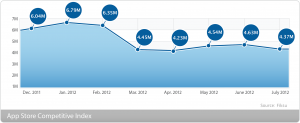China Leads in New iOS and Android Activations
I’m just as hooked on my phone as most of us, but when I read that China was crushing it in “new iOS and Android activations,” I had to know more. In 2012, Flurry, a mobile analytics firm, dropped a wild stat: China had jumped from 11th place to number one globally in “new activations” for iOS and Android devices, passing the U.S. in just a year. They also reported a crazy 1,126% spike in “app sessions” in China from Q1 2011 to Q1 2012. That’s some serious growth, and it made me wonder: why did China take the lead, and are they still the smartphone champs in 2025? Let’s unpack Flurry’s findings, figure out what fueled China’s boom, and see where things stand now.
Flurry’s 2012 Reveal: China’s on Top
Back in March 2012, Flurry’s report, covered by TechCrunch, showed China rocketing from 11th to first in “new iOS and Android activations.” In January 2011, the U.S. held 28% of global “activations,” while China had just 8%. By February 2012, China pulled ahead with 23% to the U.S.’s 22%, and Flurry predicted China would hit 24% by March. That’s a huge leap in barely a year. Even wilder, China’s “app sessions” grew by 1,126% year-over-year, leaving other markets in the dust, according to Flurry’s blog.
So, what’s a “new activation”? It’s when someone sets up a new iPhone, Samsung Galaxy, or other iOS/Android device and starts using it. Flurry tracked this through analytics in apps, measuring over a billion daily “app sessions” (one session = opening and using an app). China’s surge wasn’t just about numbers—it showed a smartphone obsession taking hold, with an “installed base” twice the size of the U.K., the next biggest market, per VentureBeat.
Why China Took the Lead in “New Activations”
I’ve seen tech trends spread fast, but China’s 2011–2012 smartphone explosion was unreal. Here’s what drove their lead:
- Massive Population, Rising Wealth: China had over 980 million mobile users in 2012, per TechCrunch. A growing middle class could finally afford smartphones, moving beyond basic feature phones. Flurry pointed to China’s “increasing affluence” as a key driver.
- Cheap Android Phones: Android’s open platform let brands like Xiaomi and Huawei flood the market with affordable devices. By 2014, Android had 79% of China’s smartphone market, per South China Morning Post.
- Apple’s iPhone Hype: Apple opened its first China store in 2008 and grew to 50 by 2020, per BBC. The iPhone’s status as a luxury item hooked wealthier buyers, boosting iOS “activations.”
- App Culture Boom: Chinese users went all-in on apps for socializing, gaming, and shopping. Gamezebo’s 2012 report noted that China’s app downloads were second only to the U.S., with “app sessions” skyrocketing.
- New Market Energy: The U.S. was a mature market with slower growth, but China was wide open. Flurry showed the U.S. doubled its “app sessions,” but China’s 1,126% surge was unmatched, per USA Today.
This combo of people, affordable tech, and app craze turned China into a smartphone juggernaut.
The 2012 Numbers: China vs. Everyone Else
Flurry’s data, as reported by BGR, lays it out clearly. Here’s the snapshot:
| Metric | China (Q1 2012) | U.S. (Q1 2012) | Global Context |
|---|---|---|---|
| Share of New Activations | 24% (projected) | 21% | China overtook U.S. in Feb 2012 |
| App Session Growth | 1,126% YoY | 100%+ YoY | China led all countries |
| Installed Base | 2x U.K.’s size | 2x China’s size | China catching U.S. fast |
| App Economy Rank | #2 globally | #1 globally | China poised to take over |
China’s “new activations” showed a market on fire, with an “installed base” double the U.K.’s and a path to challenge the U.S., per Red Herring.
Is China Still King in 2025?
Flurry’s 2012 report is old news in tech land, so I looked into whether China still rules “new activations.” The answer’s a bit mixed:
- Smartphone Market in 2024: Android holds 77% of China’s market, with iOS at 22%, per Statista. Local brands like Huawei, Xiaomi, and Vivo lead, but Apple topped sales in 2023 with 17.3% market share, per Investopedia.
- Slowing Growth: China’s market is maturing, and foreign smartphone shipments, including iPhones, fell 47.4% in November 2024, per Reuters. Domestic brands are squeezing Apple, hinting at fewer iOS “new activations.”
- Huawei’s HarmonyOS Surge: Huawei’s HarmonyOS hit 19% market share in China in Q4 2024, outpacing iOS, per Counterpoint Research. This could cut Android “activations” as Huawei ditches Google.
- Global Picture: Android’s 74% global market share crushes iOS’s 25%, but iOS drives more revenue—$85.1 billion in App Store spending in 2021 vs. Google Play’s $47.9 billion, per Exploding Topics. China’s “activations” are high, but spending per user lags behind the U.S.
With 1.4 billion people and strong local brands, China likely still leads in raw “new activations,” but markets like the U.S. and Japan (68.86% iOS) have higher per-user spending, per PCMag.
What Fueled China’s Smartphone Culture?
Beyond Flurry’s numbers, I’ve noticed China’s smartphone boom was about more than just devices. It was a cultural shift:
- WeChat and Super Apps: WeChat, launched in 2011, became a one-stop app for messaging, payments, and more, driving smartphone adoption. By 2012, it had 100 million users, per TechCrunch.
- Mobile Gaming Surge: Games like Honor of Kings exploded, with China’s mobile gaming market hitting $12 billion by 2017, per Gamezebo. This boosted “app sessions.”
- E-Commerce Boom: Platforms like Alibaba and JD.com made smartphones essential for shopping, with mobile commerce soaring by 2012, per South China Morning Post.
- Urban Adoption: China’s urban centers, home to 60% of its population by 2012, embraced smartphones faster than rural areas, per BBC.
These trends turned smartphones into a way of life, not just a gadget.
Challenges for China’s Smartphone Market
China’s lead in “new activations” hasn’t come without hiccups. Here’s what I’ve seen holding them back:
- Market Saturation: With nearly everyone owning a smartphone—1.4 billion mobile users by 2024, per Statista—growth is slowing, especially for iOS.
- Domestic Competition: Huawei, Vivo, and Xiaomi dominate, squeezing Apple’s iOS share. Huawei’s HarmonyOS is a wildcard, per Counterpoint Research.
- Economic Pressures: China’s economic slowdown in 2024, with flat consumer spending, hurts premium iPhone sales, per Reuters.
- Global Trade Tensions: U.S.-China trade issues, like tariffs, impact Apple’s supply chain, raising iPhone prices and slowing “activations,” per Investopedia.
My Playbook for Understanding China’s Market in 2025
If you’re a developer or just curious about China’s smartphone scene, here’s how I’d approach it:
- Focus on Android for Volume: Android’s 77% market share in China makes it the go-to for reaching the most users, per Statista.
- Target iOS for Revenue: iOS users spend more, so premium apps or in-app purchases do better on iPhones, per Exploding Topics.
- Watch HarmonyOS: Huawei’s OS could disrupt Android’s dominance, so keep an eye on its growth, per Counterpoint Research.
- Leverage Super Apps: Build for platforms like WeChat to tap China’s app culture, as TechCrunch suggests.
- Localize Content: Chinese users love apps tailored to their culture—think gaming or e-commerce integrations, per Gamezebo.
Why China’s Lead Matters in 2025
Flurry’s 2012 report showed China’s smartphone market was a force, and even with a maturing market, it’s still a giant. The 1,126% “app session” growth and leap to first in “new activations” were early signs of a tech-driven culture that’s now global. While domestic brands like Huawei challenge Apple, China’s sheer scale keeps it a leader in “activations.” For developers, it’s a market you can’t ignore—whether you’re chasing volume with Android or revenue with iOS.



